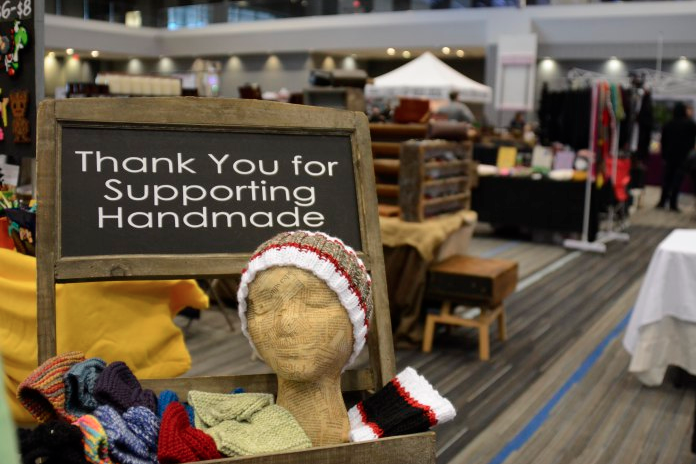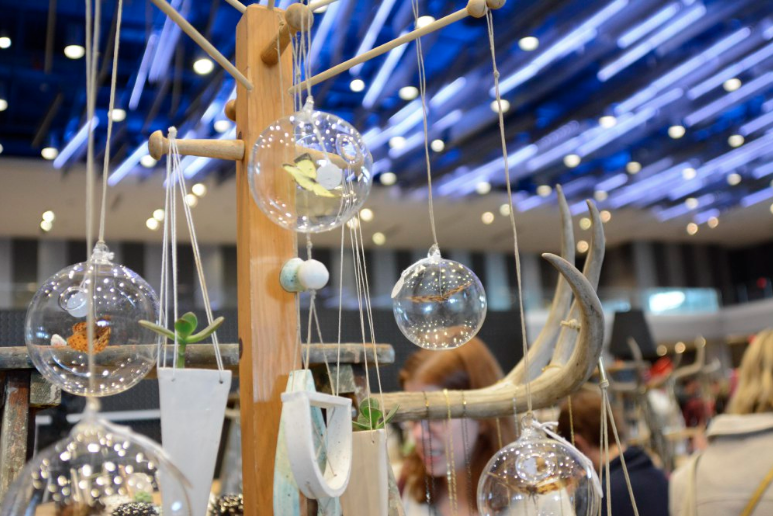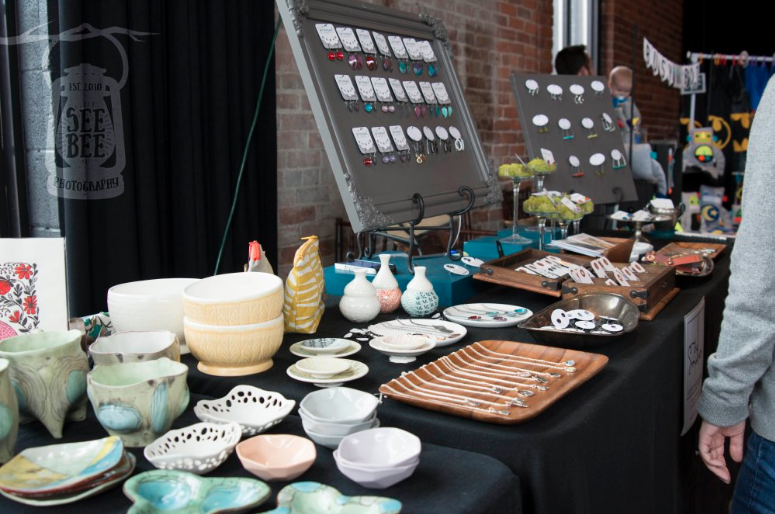
Craftin’ Outlaws Holiday 2015 craft fair.
Photos by SeeBee Photography
Let me offer you a peek into my crazy life. At any given moment, I’m juggling five different events of the crafty variety. I recently wrapped up my 15th craft production, a spring event featuring 38 artists. Planning for that one started seven months before the actual event date — at which time, I also was planning a holiday craft show for 110 vendors, working on hosting an inaugural craft conference, running my own handmade soap business and preparing for the typical hectic period of a handmade holiday season.
This is my job, year after year. I openly invite chaos and stress into my life, all in the name of craft.
More or less, this is how it all goes down:
Choosing the date
Let’s start at the beginning. When it comes to planning a craft show, everything starts with a date and a venue. When choosing the date, research is key.
Beyond avoiding major holidays and other big events, I consider other possible glitches with event dates. Here are just a few of the things I’ve thought about when planning a craft show: Living in a college town where football shuts down the city on Saturdays, I never host an event on a game day. Should I give myself some time before and/or after the baby’s due date? Do I really think people will show up the day before Easter? Does the release of a sequel to a popular tween movie about vampires coincide with the date? (Incidentally, this actually helped attract new customers — especially when the fair happens to be housed at a movie theater. Thanks, “Twilight.”)
Finding a venue
Once a date is decided, it’s time to choose a venue. A short list of questions to ask when you’re searching for the perfect venue:
- How many tables or booths will the space support?
- How is parking?
- Are there other events going on the same day within the building?
- What’s the Wi-Fi situation?
- Is there a loading dock?
- How much of a deposit is needed to put down?
- Will the venue help with any advertising?
- Am I allowed to set up my own tables and chairs, or does their staff need to handle that task?
- Can I have access to the building the day or night before, or does that mean renting the space for two days?
- What other services (i.e. staging, audio-visual) does the facility offer?
- Does the venue allow food trucks or will I have to utilize their caterer?
- Can I sell beer?
Since one shouldn’t start charging exhibitors for an event that doesn’t have a venue, and you can’t book a venue without first coordinating these details. The bigger the venue, the longer the fine print. I spend a great deal of time reading contracts and consulting with a lawyer.

Craftin’ Outlaws Holiday 2015 craft fair.
Photos by SeeBee Photography

Craftin’ Outlaws Spring 2015 craft fair.
Photos by SeeBee Photography
Creating a budget
The venue contract gives me a good idea of what I’ll need to charge for vendor space, but many other factors go into determining what I can charge vendors and the general public.
Our events have grown in size and staff over the years. We’ve gone from $65 table fees with 50 vendors to $200 booth fees with 105 exhibitors. We charge a non-refundable application fee as well, but we do not charge an admission cost for the general public.
Do some quick math and you’ll figure a craft fair can make upwards of $21,000 per event. But don’t think I’m living high off the craft hog — a well-run event will burn through that budget very quickly.
Venue rental can cost anywhere from $2,000 to $8,000. Annual insurance for an event can run upwards of $1,000. Tables and chairs are often an a la carte cost, and can go as high as $200 to $1,500 (which may or may not include the cost of installation and delivery charges).
After considering these vendor costs, I factor in marketing costs — everything from postcards, posters and programs to sponsored ads on social media and paid ads in local print publications and on radio and television.
And it’s not like I’m planning to do everything — managing contracts, overseeing social media, communication with vendors, fostering sponsor relationships, writing press releases, designing marketing materials and updating websites by myself? No, thanks.
The best-run craft shows operate with a staff or, at the very least, a partner to offset the workload. I run my events with the help of many people — including two paid assistants, a PR agent and two designers — and all of them are integral to helping my events run smoothly while saving my personal relationships.
Building relationships
By far, the most rewarding experience for me as a craft fair organizer is building relationships with everyone from sponsors to exhibitors to customers to the venue staff. Creating sustainable relationships and building a community is what craft fairs are all about. We are creating an experience for our city, as well as for the customers who frequent our events and spend their money with our exhibitors.
The exhibitors are the heart and soul of our event. The vendors selected define our craft show’s experience. We spend a great deal of time thinking about the types of vendors we’d like to be part of our event. We spend three to five hours hosting a jury and reviewing every application that comes in. Sadly, it means not everyone gets in. This is by far the worst part of the job. To keep my event authentic, we first find vendors that fit our aesthetic. Sometimes it means longtime vendors are not accepted to make room for new talent. This process becomes tough because we’ve seen vendors grow and have made friends with them over the years.
Our customers are the other big part of the craft show equation. As an organizer, it’s my job to create an experience customers will remember and to keep them coming back. All of our marketing efforts are used to attract new customers and to keep the word-of-mouth going strong.

Craftin’ Outlaws Holiday 2015 craft fair.
Photos by SeeBee Photography
Behind the scenes, I’m constantly working to create relationships with small businesses in my community. These businesses, in turn, can add more depth to my event and build support from our community.
Like most everything in the handmade business, these relationships take time to develop, but they’re all an integral part of creating a presence at our events.
Event day
With the event day comes the rush of commerce. It’s a blur of setting up tables, meeting old and new friends, shopping, maybe kicking back a drink or four, managing volunteers, recognizing sponsors, putting out fires and checking in with vendors. Then it’s all about tearing down tables, assisting with load-outs and doing one last walk through the venue.
Go home and sleep it all off because — this is the tough part — there is still a lot of work to do!
The aftermath
Craft Show Organizing 101 Tip: Months in advance, book a massage session for yourself to take place the day after your event!
After I have taken a moment for myself, it’s time to wrap up those loose ends. Final contracts still need to be paid and follow-ups and thank-you cards need to be sent. Surveys are sent to assess how things really went for vendors behind the scenes. We collect information such as: how much did they sell and can they offer suggestions for improvements? Then, we use that data to create another successful event in the future and learn from our mistakes.
Now that one event has closed, I can dive back into the other events that have been sitting quietly on my calendar, awaiting my full attention. But first thing’s first — I need to call my masseuse.

Megan Green
contributor
Megan is a hard core maker who continues to bring a highly curated selection of handmade goods to her hometown of Columbus, Ohio and through her organization of Craftin' Outlaws. Megan is also the owner of Stinkybomb Soap, co-organizer of Midwest Craft Con, mother of two, wife to one and lover of all things craft related.

Megan—I’ve birthed two artisan events in the Northwest for quilters and textile lovers that are much smaller—but with similar details. Thanks for this info from a pro. PB
Thanks so much Patricia! Hats off to you from one organizer to another. It’s all a labor of love.